25 Most Influential Political Science Books 2010–2020

Political science studies systems of governance, structures of power, and the various constitutions, laws, and behaviors connected to these systems and structures. This definition encompasses many things, including the different forms of government—such as monarchy, oligarchy, and democracy—the various legal traditions in existence (Roman, English common law, etc.), the historical development of political and legal institutions, and much else.
Taking the breadth of the field into consideration, we have compiled a list of the most influential books in political science from the past decade (2011–2021). We have assigned an objective measure of “influence” to each book on the basis of the number of references it has received in both the academic literature and the popular media.
Note that our list does not necessarily represent the most popular political science books overall published during the past ten years, nor is it a straightforward list of political science bestsellers during that time frame—for several reasons.
For one thing, we have excluded political science textbooks, as well as sacred texts and fictional works which may contain political science-related material.
Several works included on this list are classics in the field, and thus quite old. Nevertheless, ours is not a list of the most influential political science books of all time. Such a list would have a very different look and feel to it.
Rather, our list provides you with the 25 books on political science that have had the greatest combined academic and popular impact over the past decade.
If you’re interested in dedicating your college education to these and other essential political science texts, check out The Best Colleges & Universities for a Bachelor’s in Political Science.
Otherwise, read on for a look at The 25 Most Influential Books in Political Science.
25 Most Influential Books in Political Science
1.The Reactionary Mind: Conservatism from Edmund Burke to Donald Trump
By: Corey Robin , 2011
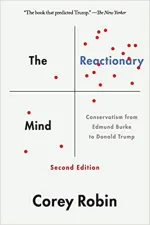

Robin (b. 1967) is a professor of political science with appointments at both Brooklyn College and the Graduate Center of the City University of New York. The present book is a history of conservative thought in the European tradition from the eighteenth century to the present. In it, the author claims that the overriding motive of conservative thinkers, despite their explicit statements to the contrary, has been simply to cling to power by maintaining an undemocratic, hierarchical society. A second edition was published in 2018, which extended the book’s historical scope to take into consideration the administration of US President Donald J. Trump.
2.Democracy in America
By: Alexis de Tocqueville , 1835


Alexis Charles Henri Clérel, comte de Tocqueville (1805–1859), was born in Paris to Norman parents of aristocratic stock. His great-grandfather, Malesherbes (1721-1794), was a minister under both Louis XV and Louis XVI, before ending his life on the guillotine during the Reign of Terror. Despite his service to the Bourbons, Malesherbes was a man of the Enlightenment who worked for the liberalization of the ancien régime and whose ideas had a decisive impact on his great-grandson. It must be stressed, however, that the “liberalism” of Malesherbes and Tocqueville was of the “classical” sort associated with constitutional monarchy, free trade, and freedom of religion, speech, and the press, and thus was a far cry from the liberalism of our day. Tocqueville, together with his friend Gustave de Beaumont (1802–1866), traveled to North America in 1731 on a mission from the French government to report on the prison system in the US. The pair traveled overland from New York to New Orleans, then back via the Mississippi and Ohio Rivers. They also traveled through southern New England, upstate New York, the Great Lakes, and lower Canada. In drawing up a literary account of his travels and observations, Tocqueville went far beyond his original remit, creating with Democracy in America a masterpiece and a social science classic that set a new standard for the dispassionate description and analysis of social, economic, and political life, not just in the US, but generally. The book was published in Paris in 1835 as De la démocratie en Amérique and was translated into English almost immediately. A second volume came out in 1840. There has been a total of six English translations to date, including the one linked to here, translated by Arthur Goldhammer, and published in 2004.
3.Atlas Shrugged
By: Ayn Rand , 1957
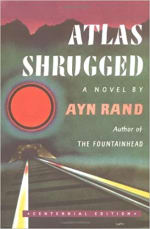

Rand (1905–1982) was a Russian-born novelist and philosopher. Although professional philosophers are taking an increasing interest in her nonfiction works today, she remains best known to the general public for her novels, especially the one listed here and the preceding one, The Fountainhead, published in 1943. These books are massive novels of ideas intended to illustrate her radically libertarian, if not anarcho-capitalist, philosophical views. Both books portray creators and builders, who prefer to sacrifice their life’s work than to allow it to be misused by others. Specifically, Atlas Shrugged portrays a world in which the creative individuals—the ones who, like Atlas, bear the world on their shoulders—go on strike. Rand’s work has had a considerable impact on several generations of thinkers, especially economists, a surprising number of whom acknowledge Rand’s influence on them—usually when they read her novels at a tender age. The book has been reprinted numerous times.
4.The Federalist Papers: A Collection of Essays Written in Favour of the New Constitution
By: Alexander Hamilton , James Madison , and John Jay 1787-1788
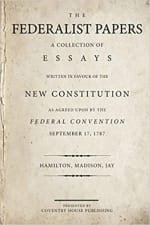

In 1775, in the wake of the battles of Lexington and Concord and with a wider war looming, the 13 American colonies sent representatives to Philadelphia to what became known as the Second Continental Congress. That body drew up a document creating a central government on the basis of a loose confederation from among the colonies. These Articles of Confederation were finally ratified in 1781. However, frustration with the new government’s weakness and inefficiency was so widespread that a new meeting was called in Philadelphia in 1787 for the purpose of designing a new constitution establishing a tighter federal union with a stronger executive branch. The new document was hammered out between May and September of 1787 and then sent to the states for ratification. The next two years saw a highly contentious debate in the press for and against the adoption of a new, stronger federal government. Three of the chief voices arguing for adoption of the constitution were those of Alexander Hamilton (1755–1804), James Madison (1751–1836), and John Jay (1745–1829). Beginning in October of 1778 and ending in May of 1788, they wrote 85 articles—mostly independently, but a few jointly—laying out with careful logic and polished eloquence the case in favor of a stronger union. Immediately, in May of 1788, these essays were collected and published in a volume entitled The Federalist (popularly known as “The Federalist Papers”). The new constitution was ratified and took effect in 1789, in no small part thanks to the essays collected in The Federalist, which has been published in a great many different editions over the years.
5.Gulag: A History
By: Anne Applebaum , 2004
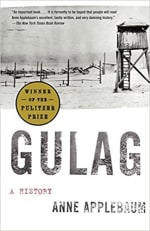

This riveting book is a detailed history of the USSR’s use of prison camps where criminals and political prisoners were forced to perform hard labor under horrifying conditions in remote locations in Siberia and elsewhere. Applebaum (b. 1964) is an American journalist specializing in the history of Marxism, communism, and socialism, especially in the countries of eastern and central Europe. In this book she explains how the prison camps were initially set up on the orders of Lenin from the earliest days of the Bolshevik seizure of power in 1917. The term “gulag” is a Russian acronym referring to the administrative authority governing the camps. Alexander Solzhenitsyn famously dubbed the camps sprinkled like islands throughout the vastness of Siberia as an “archipelago”—whence the phrase “Gulag archipelago,” which is also the title of Solzhenitsyn’s great, three-volume history of the camps compiled surreptitiously during the 1970s. Following the demise of communism and the collapse of the USSR, Applebaum had the advantage of being able to work openly and of having far greater access to government archives. It is interesting that her succinct and readable treatment of essentially the same material corroborates Solzhenitsyn’s work on nearly all major points.
6.Theory of International Politics
By: Kenneth Waltz , 2010


Kenneth N. Waltz (1924–2013) was a political scientist at UC-Berkeley and Columbia University. This book is an in-depth analysis of relations among nations and their governments from a variety of different perspectives. These include the conceptual foundations of political theory, the main types of political theories, the principal kinds of empirically existing political structures, the relation between political structures and economic effects, the relation between political structures and military effects, and, finally, the overall management of international affairs. The author’s approach is broadly “neorealist,” meaning he maintains that the principal emphasis in international politics ought to be on national interests.
7.The Bell Curve: Intelligence and Class Structure in American Life
By: Richard Herrnstein and Charles Murray , 1994


Herrnstein (1930–1994) was a psychologist at Harvard University, while Murray (b. 1943) is a political scientist currently at the American Enterprise Institute (AEI). This highly controversial book is a detailed discussion, based on careful statistical analyses, of aspects and consequences of the gap in the performance of various ethnic groups on intelligence tests. After an initial discussion of the history of IQ testing, the book turns to such topics as the impact of the performance gap on such things as family stability, educational attainment, employment, and criminal behavior. From the moment of its publication, the book was denounced as seriously flawed both conceptually and empirically. The controversy continues nearly three decades later, stimulated by Murray’s continuing presence as an author and public intellectual. However, denunciations of the book now tend to reject it out of hand as blatantly racist and unworthy of serious discussion.
8.Consent of the Networked: The Worldwide Struggle for Internet Freedom
By: Rebecca MacKinnon , 2012
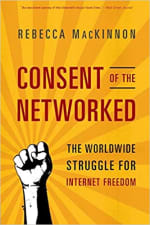

MacKinnnon (b. 1969) is a journalist who specializes in the impact of the Internet on politics and society. This book takes a detailed look at both the older and more recent histories of the relationship between Internet companies and governance, focusing on the way in which IT companies are gradually usurping the functions of government. It includes a provocative account of the Chinese Communist Party (CCP) and its policy of surveilling and controlling the Chinese population by means of controlling their Internet access. The author also highlights how globalized (though notionally American) corporations have aided and abetted the CCP in this effort. The author ends by arguing that Americans must become more aware of what the IT companies did in China if we are to avoid the same fate.
9.Bowling Alone: The Collapse and Revival of American Community
By: Robert D. Putnam , 2000


Putnam (b. 1941) is a Harvard University political scientist. His highly influential book, Bowling Alone, drew attention to a troubling trend in American life that has only grown more acute over the two decades since the book’s publication: namely, a decline by Americans in political involvement, which the author believes is strongly correlated with a decline in participation in local community social activities. One example is the disappearance of once-ubiquitous American bowling leagues, as indicated by his emblematic title. The book is divided into four major sections: (1) the evidence for a decline in a range of social activities; (2) the possible causal factors involved; (3) the implications for other social and political areas of life; and (4) ideas for how to deal with the problem. A revised and updated edition with a new chapter focused on social media was published in 2020.
10.States and Social Revolutions: A Comparative Analysis of France, Russia, and China
By: Theda Skocpol , 1979


Skocpol (b. 1947) is a Harvard University sociologist and political scientist. The topic of the book is announced in its subtitle: a comparative history and socio-political analysis of the French, Russian, and Chinese revolutions. Her method is to examine these three historical episodes in terms of a threefold explanatory framework of state structures, international forces, and class relations. Skocpol rejects both Marxist and liberal causal theories of revolutions in favor of a new theory of her own devising. In a nutshell, she favors (1) acknowledging that administrative and coercive state institutions are potentially autonomous from class controls and interests and (2) making the nature and interests of such institutions central to investigations into the causal factors that lead to revolutions. The book was reprinted in 2015.
11.The Hedgehog and the Fox: An Essay on Tolstoy’s View of History
By: Isaiah Berlin , 1953


Berlin (1909–1997) was born into an affluent Jewish family living in Riga in what was then imperial Russia. He grew up in a polyglot environment, equally comfortable speaking Yiddish, German, Russian, French, and English. He spent his career as a political theorist and historian at Oxford University in the UK. This book is an extended essay into the history of ideas. It takes its title from the ancient Greek poet Archilochus (680–645 BC), who wrote in one of his poems, “the fox knows many things, but the hedgehog knows one big thing”—a set phrase that has become widely recognized by many people who do not know its origin. In this book, the author classifies thinkers as either foxes (for example, Aristotle, Montaigne, Shakespeare, Goethe) or hedgehogs (Plato, Lucretius, Dante, Pascal). The essay was originally published in a book in 1953 but has been reprinted several times in anthologies. A new edition of the essay was published in monograph form in 2013.
12.Jihad vs. McWorld: How the Planet Is Both Falling Apart and Coming Together and What This Means for Democracy
By: Benjamin Barber , 1995


Barber (1939–2017) was a political scientist at the University of Maryland. A prolific author of academic and popular works, the book under consideration here is probably his best-known work. By “jihad” the author means, not just actual Islamist-inspired terrorism, but the social and cultural factors that support the survival of tribal and other traditional allegiances into the modern world. “McWorld,” on the other hand, is his shorthand term for the globalized consumerist culture fueled by the giant transnational corporations. The bulk of his book consists of Barber’s analysis of the ways in which both of these forces are inimical to democracy. He ends by recommending a new form of political organization, which he calls “confederalism,” that he believes could successfully accommodate and eventually absorb both of these seemingly diametrically opposed social forces. The book has been reprinted several times with varying subtitles.
13.The Arthashastra
By: Chanakya , 300 BC


The ancient Indian philosopher commonly known as Kauṭilya (375–283 BC) is also known by the alternative names of Chanakya and Vishnugupta. He acted as an advisor to Chandragupta, the founder of the Maurya Empire. He is thought to have written the Arthashastra in the late fourth or the early third century BC. However, the Sanskrit text that has come down to us was expanded by many hands over the next several centuries, and was probably not completed until the third century AD. It was lost sometime in the sixth century AD and was not rediscovered until the early twentieth century. The Arthashastra (the name means, roughly, “the science of wealth”) is a wide-ranging treatise on political theory and economics, encompassing types of governments, legal codes, markets and trade, diplomacy, war, and military strategy. The dispassionate and objective tone of Kauṭilya’s Arthashastra has drawn comparisons to Machiavelli’s The Prince (see #22 below).
14.The End of History and the Last Man
By: Francis Fukuyama , 1992


Fukuyama (b. 1952) is a second-generation Japanese-American political scientist who is currently associated with Stanford University. It was the publication of this book just three years after the fall of the Berlin Wall in 1989 (“the end of history”) which catapulted him to fame as a prominent public intellectual. The “last man” in the title alludes to a concept developed by Friedrich Nietzsche (1844–1900) in Thus Spoke Zarathustra (1885). In that book, the German philosopher presents “the death of God” as raising two prospects for humanity: a spiraling descent into moral nihilism (the last man) or the birth of a new form of humanity (the Übermensch [“superman”]). Fukuyama’s basic thesis was that the demise of communism represented the permanent victory of liberal democracy over all other political ideologies. However, he did not view this event as an unmixed blessing due to the looming danger of the replacement of ideologies by consumerist hedonism. In that case, liberal democratic man would be like Nietzsche’s amoral and egotistical last man, caring for nothing but his physical existence and pleasures. The book was reprinted with a new Afterword by the author in 2006.
15.The Israel Lobby and U.S. Foreign Policy
By: John Mearsheimer , 2007


Mearsheimer (b. 1947) is a political scientist at the University of Chicago. He is best known for his brand of political realism, known as “offensive realism,” according to which the competition between great powers is entirely rational, being driven by each power’s interest in achieving regional hegemony in order to protect itself from the threat of instability and potential anarchy. The book under consideration here is an analysis of American Middle East policy on the basis of the author’s offensive realism. Its basic contention is that the inordinate influence (as Mearsheimer sees it) of the American Israel lobby has skewed both American and Israeli policy in an unrealistic direction, which has destroyed the possibility of a two-state solution and is leading inexorably to an “apartheid” state incorporating Gaza and the West Bank. The book—and a 2006 essay upon which it was based—have been harshly criticized by American supporters of Israel, with some (notably, then-Harvard Law School professor Alan Dershowitz ) going so far as to call the author’s characterization of the Israel lobby anti-Semitic.
16.Fire and Fury: Inside the Trump White House
By: Michael Wolff , 2018


Wolff (b. 1952) is an American journalist and political columnist. He was given access to the White House by President Donald J. Trump during the early days of his administration. Trump originally accorded Wolff this access because of a profile he had written for The Hollywood Reporter during the 2016 campaign. However, after this highly sensationalistic book—which depicts a chaotic, internally divided administration—was published in 2018, Trump denied he had ever given Wolff the level of access he claimed, stressing that Wolff did not interview him personally. The book was heavily publicized by the highly-politicized media environment of the time, while many of its often-salacious claims have been hotly disputed by others.
17.Losing Ground: American Social Policy, 1950–1980
By: Charles Murray , 1984
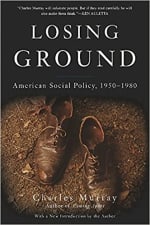

Murray, a highly prolific political scientist and public intellectual, published this book a decade before his hugely controversial Bell Curve (see #7 above). In it, he outlines the efforts of successive post-war US administrations over three decades to devise public policies that would help ameliorate the persistent problem of poverty in America. On the basis of careful analysis of copious statistical evidence, the author concludes that policies like President Lyndon Johnson’s “Great Society” welfare programs are actually counterproductive. According to Murray, such policies make the problem of poverty worse because they create perverse incentives that reward destructive short-term behaviors, while punishing behaviors—such as marriage and family-formation—which would help people escape from poverty over the long run. The book was widely criticized upon its release as a thinly veiled apologia for President Reagan’s government-spending cutbacks. On the other hand, President Bill Clinton has said that the book had an important influence on his administration’s 1996 welfare reform act.
18.The Origins of Political Order: From Prehuman Times to the French Revolution
By: Francis Fukuyama , 2011
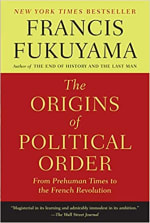

In this follow-up to his hugely influential 1992 magnum opus, The End of History and the Last Man (see #14 above), Fukuyama has taken on board an even more ambitious assignment: to investigate the nature of human social and political order from its earliest manifestations in prehistory up until the Enlightenment, culminating with the French Revolution. In so doing, he draws upon a vast wealth of academic literature, beginning with what the discipline of primatology has to say about the likely social structure of our hominin ancestors and moving on to the contributions of archaeology and anthropology to our knowledge of traditional hunter-gatherer and tribal societies, as well as the transition to agriculture, the division of labor, cities, social stratification, and kingdoms and other kinds of states. The author then focuses on more traditional historical sources, tracing the beginnings of the rule of law in India and Mesopotamia, as well as the development of constitutional and other forms of limitation on governmental power in the Mediterranean basin and later Western Europe during the ancient, medieval, and early modern periods.
19.The Prince of Providence: The Rise and Fall of Buddy Cianci, America’s Most Notorious Mayor
By: Mike Stanton, 2004


In this book, Pulitzer Prize-winning journalist Stanton turns a jaundiced eye on urban politics in modern America. Vincent Albert “Buddy” Cianci, Jr. (1941–2016), served as mayor of Providence, RI, on two different occasions for a total of more than two decades, from 1974 until 1984 and again from 1991 until 2002. On both occasions, Cianci had to step down from office due to felony convictions. In 1984, he pled “no contest” to charges of involvement in the kidnapping and torture of a man who had been his wife’s lover (his five-year sentence was suspended). Then, in 2002, he became the subject of an FBI undercover investigation and was caught on film accepting a bribe. In addition to bribery, he was also charged with racketeering, conspiracy, extortion, witness tampering, and mail fraud. Upon conviction, he served five years in the federal penitentiary at Fort Dix, NJ. In between his two terms of office as mayor, Cianci was a popular Providence radio talk-show host. Stanton’s account of these colorful events is both entertaining and thought-provoking.
20.From Time Immemorial: The Origins of the Arab-Jewish Conflict over Palestine
By: Joan Peters , 1984


Joan Peters (née Friedman) (1936–2015) was an American journalist. In 1973, she covered the Yom Kippur War as a freelancer for CBS News—an experience which led to her becoming obsessed by the Israeli-Palestinian conflict. In this book, she argues that British Mandate policy fostered immigration of both Jews and Arabs during the 1920s and 1930s, with the result that, like the Jews, the majority of the Arabs living in Palestine in 1948 were relatively recent arrivals with family roots in other countries. The book was roundly condemned for “shoddy scholarship,” particularly by the political scientist Norman Finkelstein—whose own work on the Israeli-Palestinian conflict has been highly controversial. Two of Peters’s early defenders, the historian Daniel Pipes and the journalist Ronald Sanders , later admitted that her work contained serious factual errors, although Sanders held the mistakes did not invalidate her fundamental thesis.
21.The Republic
By: Plato , c. 375 BC
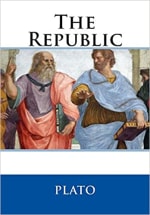

Plato (c. 428–c. 348 BC) may be regarded as the father of political theory. The Republic (Politeia, in Greek) is one of the main texts in which he discusses political ideas, along with the Laws, the Statesman, and a few of his shorter dialogues. One of Plato’s longest works, The Republic is divided into ten “books.” The dialogue—which features Socrates and Plato’s elder brother, Glaucon , among several other characters—begins with a discussion of the origin and nature of justice. It then broadens out into a consideration of the nature of an ideal (utopian) society governed by a class of rulers educated to be philosophers (“philosopher-kings”), followed by a consideration of the pros and cons of the three main types of government: tyranny (rule by one), oligarchy (rule by a few), and democracy (rule by the many). Several of Plato’s most famous literary conceits appear in the Republic, including “Gyges’s ring” (ring of invisibility) in Book II, the Myth of the Cave in Book VII, and the Myth of Er in Book X. The Republic has been translated into English numerous times.
22.The Prince
By: Niccolò Machiavelli , 1532


Machiavelli (1469–1527) wrote a Latin work entitled De principatibus (On Principalities) sometime around 1513. It circulated privately in manuscript among his friends for many years, but was only printed after his death, in 1532, in an Italian translation entitled Il Principe. The Prince belongs to the late-Medieval and Renaissance genre known as “mirrors for princes”—works of instruction and practical advice addressed to princes, kings, and those responsible for the education of future rulers. To this established genre, Machiavelli added a new wrinkle: he eschewed all moral counsel and religious edification in favor of a coldly dispassionate and realist assessment of the internal and external forces with which a ruler must contend if he is to successfully defend his throne. The Prince has been translated into English numerous times.
23.The Great Transformation: The Political and Economic Origins of Our Time
By: Karl Polanyi , 1944


Polanyi (1886–1964) was a Hungarian-born economic historian. His younger brother, Michael (1891–1976), was a distinguished chemist and philosopher. While the Great Transformation is Karl Polanyi’s best-known work, he wrote several other highly regarded studies, notably, Trade and Markets in the Early Empires (1957). The book under consideration here is a historical study of the social and political repercussions of the development of the market economy during the course of the nineteenth century in England. The author’s principal thesis is that the rise of the market economy caused a radical change in people’s ways of thinking and understanding the world. The book was reprinted in 1957, and a second edition was published in 2001.
24.Democracy and Political Ignorance: Why Smaller Government Is Smarter
By: Ilya Somin , 2013


Somin (b. 1973) is a Russian-born professor of law at George Mason University. This book is a study of the relationship between democracy and the ignorance of most contemporary citizens about political matters. First, the author points out that political ignorance may be quite rational, inasmuch as citizens rightly understand that their vote has little practical relevance and therefore they tune out political news which has no intrinsic interest for them. Somin then considers various solutions, ultimately arguing that people make better decisions when they have the incentive to acquire relevant information. Therefore, the effects of political ignorance may best be counteracted by making politics more relevant to people’s lives, which may best be achieved by decentralizing and limiting the size of government. A second edition was published in 2016.
25.The World as It Is: A Memoir of the Obama White House
By: Ben Rhodes , 2018
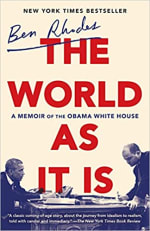

Rhodes (b. 1977) was Deputy National Security Advisor for Strategic Communications and Speechwriting during the administration of President Barack Obama. For almost ten years, he gave the President his daily briefing. Thus, the author had unprecedented access, which enabled him to bring great political insight, as well as journalistic expertise, to this project. In addition, before entering politics, Rhodes had been an aspiring novelist. For this reason, this book is not only highly informative and historically valuable, it is also carefully crafted from a narrative and dramatic point of view. As a result, the book is as delightful to read as it is insightful.
Now that you know what books to check out, consider a deep dive with a look at The Best Colleges & Universities for a Bachelor’s in Political Science.
For additional study tips and tools, check out our full library of study guides for students.
Or find study tips, learning tools, tips for campus life and much more with a look at our Student Resources Headquarters.